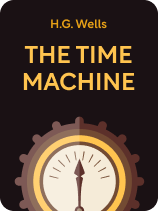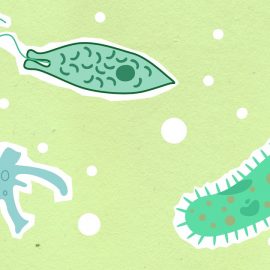

This article is an excerpt from the Shortform book guide to "The Time Machine" by H.G. Wells. Shortform has the world's best summaries and analyses of books you should be reading.
Like this article? Sign up for a free trial here.
Who are the Morlocks in The Time Machine? Are they evil? What do they represent?
In The Time Machine, Morlocks are one of the species the Time Traveller encounters in the distant future. They prove to be a serious thorn in his side, but H.G. Wells still manages to present them as somewhat pitiable characters.
Continue reading to learn about the Morlocks from this classic tale.
The Time Machine’s Morlocks
In The Time Machine, Morlocks make their appearance after the Time Traveller meets their counterpart, the Eloi. As the Time Traveller explores the world in the year A.D. 802701, he notices numerous large holes, resembling wells, going deep into the ground. He finds that the wells are part of an enormous mechanical ventilation system that’s pulling air underground.
On his fourth day in the future, the Time Traveller takes shelter in one of the many ruins. Inside it, he encounters a strange, pale, ape-like creature, larger than an Eloi though still smaller than a human. The creature immediately runs away from him. He tries to follow, but it climbs down one of the wells and disappears.
Thinking about everything he has seen since arriving in A.D. 802701, the Time Traveller concludes that humans have evolved into two species: the surface-dwelling Eloi and this subterranean race, whom he learns are called Morlocks.
(Shortform note: Humans splitting into Eloi and Morlocks are an example of divergent evolution—in other words, a single species evolving over time into multiple different species. A real-world example of this is how dogs and wolves have a common ancestor, but are now totally different animals.)
The Time Traveller further hypothesizes that these two species are the end result of the division between the upper class and the working class—a division that’s present and widening even in his own time. He muses that the rich must have forced the poor to live underground but to keep working for them. In other words, the idyllic surface world could only exist because of the mass exploitation of the working class.
(Shortform note: At this point, the future Wells envisions goes from appearing utopian (a perfect society where everyone is happy) to being revealed as dystopian (an unjust society where many people are suffering). Widespread oppression and exploitation is a common theme in dystopian novels, which—as Wells does here—often portray it as the natural endpoint of capitalism, where the majority of people live and work in inhumane conditions to enrich a relatively small upper class.)
Descending Into the Morlocks’ World
The Time Traveller is now certain that the Morlocks, not the Eloi, hid his machine (remember that the Eloi were shocked at the idea of opening the pedestal). Therefore, he decides that getting back to his own time will require going down into the Morlocks’ world to learn more about them.
The Time Traveller tries to climb down one of the wells, but when he stops to rest, Morlocks swarm and try to grab him. He lights a match so he can see his attackers, and the light scares the Morlocks away.
The Time Traveller then follows the fleeing Morlocks to a huge chamber. Inside the chamber is a table with a large hunk of meat on it. He reasons that it must be Eloi meat, since he hasn’t seen any farm animals either on the surface or underground.
(Shortform note: Just as the readers are meant to instinctively feel protective toward the Eloi, we’re meant to instinctively fear and hate the Morlocks. This is because the Morlocks are the opposite of the Eloi: While the Eloi are childlike, peaceful, vegetarian, and afraid of the dark, the Morlocks are bestial, aggressive, carnivorous, and afraid of light. These details are setting us up so that Wells can subvert our expectations by revealing that the Eloi and the Morlocks have a symbiotic relationship—in other words, each species needs the other to survive.)
The Time Traveller now understands that, while the Eloi might be the descendants of a wealthy ruling class, they’re now essentially well-kept livestock. In other words, the Morlocks continue to make clothes for the Eloi and see to their needs, while also using them as a food source.
Using the rest of his matches to keep the Morlocks at bay, the Time Traveller narrowly escapes and climbs back to the surface.
| Are the Morlocks Evil? The Time Machine doesn’t have clear-cut heroes and villains. The Morlocks are certainly the antagonists, in the sense that they’re a threat to the main character (the Time Traveller), and they try to stop him from achieving his goals of freely traveling and observing the future. However, learning that they’re (possibly) the descendants of an oppressed working class turns the Morlocks into somewhat sympathetic characters. Furthermore, while they are aggressive, it’s hard to argue that the Morlocks are truly evil. In The Lucifer Effect, psychologist Philip Zimbardo defines evil as intentionally harming innocent people—in other words, cruelty for its own sake—but that description doesn’t match what we see of the Morlocks for two reasons: 1. They hunt the Eloi for food, not for sport. It’s unclear whether the Morlocks have another food source besides the Eloi, or whether they’d be able to survive without eating Eloi meat. Also, Wells doesn’t describe the Morlocks as being especially cruel; for example, we don’t see them terrorizing the Eloi they hunt or torturing the Eloi before killing them. 2. They attack the Time Traveller in self-defense. When the Time Traveller encounters a Morlock on the surface it runs away from him. The Morlocks don’t start attacking him until he climbs down a vent and enters their territory. With that said, there are also two reasons one could argue that the Morlocks are evil: 1. They steal the time machine. We never find out the Morlocks’ reasons for taking the time machine and hiding it. Therefore, it’s possible that they stole the machine specifically to trap the Time Traveller. 2. They keep pursuing the Time Traveller and Weena. While the Morlocks don’t attack until the Time Traveller enters their territory, they also keep chasing him and trying to kill him long after he leaves it. Again, we don’t know their reasons; it’s possible they’re scared and trying to eliminate a threat (remember that they were terrified of his matches), but it’s equally possible they simply enjoy hunting and killing. |
Escaping From A.D. 802701
The Time Traveller continues to explore and finds several useful items, including a box of matches and a jar of camphor (a chemical compound that burns quickly and brightly). The Time Traveller decides to go back to the garden, hoping that he can use the lever to break open the pedestal and get his machine back.
However, the Morlocks pursue him and Weena, eventually surrounding them and trapping them in the woods. The Morlocks attack during the night. The Time Traveller kills several of them, and the rest run away. A fire he had built spread to the surrounding trees. He’s briefly tempted to kill the Morlocks—who are helpless because of the light and heat from the forest fire—but decides against it.
When the Time Traveller makes it back to the garden he’d first arrived in, he’s surprised to see that the statue’s pedestal is already open. He knows it must be a Morlock trap, but he goes inside anyway since that’s the only way to get back to his time machine. The Morlocks attack as he expects, but he manages to fight through them, reattach the control levers for the time machine, and escape further into the future.

———End of Preview———
Like what you just read? Read the rest of the world's best book summary and analysis of H.G. Wells's "The Time Machine" at Shortform.
Here's what you'll find in our full The Time Machine summary:
- An overview and analysis of H.G. Wells's 1895 science fiction novel
- A look at the science behind the story—what's real and what's fiction
- The literary techniques and symbolism Wells used to craft the story






